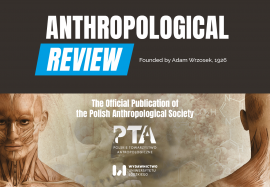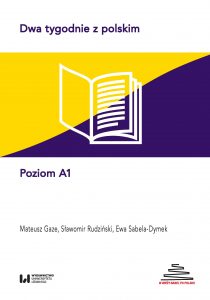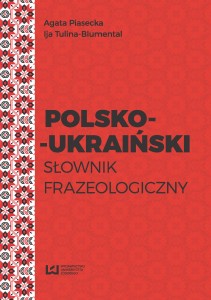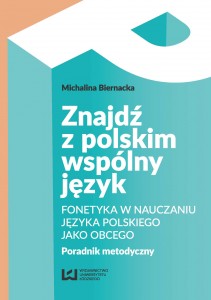Anthropological Review | Vol. 85 No. 4
Opublikowano: 9 marca 2023

“Anthropological Review” (formerly “Przegląd Antropologiczny” and “Przegląd Antropologiczny – Anthropological Review”) is the official publication of the Polish Anthropological Society. It has had a long tradition of publication since its founding, in 1926, by Adam Wrzosek, an eminent Polish physical anthropologist and physician.
The journal is published quarterly with the financial support of the Ministry of Science and Higher Education of the Republic of Poland.
It publishes (since 1997) in English, and considers submissions of original research reports, overview articles, literature reviews, meta- analyses, short notes and communications. Manuscripts submitted to this journal must not be under simultaneous consideration by any other publisher and should not have been published elsewhere in substantially similar form. No part of a paper which has been published by Anthropological Review may be reproduced or published elsewhere without the written permission of the publisher.
The journal has open access; with the online version available here. Archival issues since 1992 are available on the PTA website. A hard copy of the journal is also published.
Although this journal is primarily directed at academics, students and PhD students, it is also beneficial for experts in other fields interested in utilizing modern biology in applied science and for practical pursuits in life.
Inside Vol. 85 No. 4:
Teghan Lucas, Debra Hatfield, Maciej Henneberg
Application of forensic identification methods to establish authenticity of a historical photograph is made. Joseph Smith Junior was the Prophet and founder of The Church of Jesus Christ of Latter-day Saints, often referred to as Mormons. In 1844 Joseph and his brother Hyrum were shot and killed by a mob of angry men who opposed his church and its followers. Shortly after death, Joseph’s face was moulded, and a death mask was made. Photography was invented during the life of Joseph Smith Jnr and there are reports that he had a daguerreotype (photograph) taken, but no image has been verified to be of him.
A photographic image of an Illinois man from the 1840s is linked by circumstantial evidence, such as similar clothing, to Joseph Smith Jnr and the photographer’s studio being close to where Joseph Smith III was at the time the photograph has been produced. A morphological comparison is made between the death mask and the photograph in order to establish the likelihood that the man in the photograph is the prophet. Sixteen points of anatomical similarity were found between the death mask and the photograph, the most compelling of which is asymmetry of the face and a possible scar in the area of the left eyebrow. Superimposition confirmed morphological similarity. Finding of close morphological similarity is not an ultimate proof of identification, but increases the probability that the photograph depicts Joseph Smith Junior. This is the first case of an anatomical comparison between a death mask and a photograph.
Katarzyna Górka
Global South perspective rarely reaches the academic vanguard. While they represent over 80% of the world population, the voices from less developed regions often are ignored in academic debate. This fact produces an important disequilibrium in relation to the dissemination of knowledge, sharing of experiences and exchange of thoughts and, consequently, undermines and hinders the development of scientific disciplines. Forensic anthropology is no exception in this trend.
The present article brings up the subject of the context of forensic anthropology in Brazil to demonstrate the interconnection of the professional situation of this discipline, its structural and bureaucratic limitations and their effect on the perpetuation of human rights violation. Various aspects of daily practice of forensic anthropology in a context devoid of basic resources generate a setting that affects both the victims and their families. Despite an outstanding performance and dedication of professionals, structural limitations often substantially affect the effectiveness of their service. The present article discusses these aspects in a conceptual framework of the relation between the practice of forensic anthropology and human rights violation. In this research, Brazil serves as a case-study, an intensively studied subject that brings interpretations that can be applied in a broader context.
The article aims at opening a broader, international debate that would increase the visibility of the relationship between the practice of forensic anthropology and the structure generating and/or maintaining violence in a specific economic and legislative context especially present in the countries of the so-called global South.
Tetiana Kutseryb, Myroslava Hrynkiv, Lyubomyr Vovkanych, Fedir Muzyka, Valeryi Melnyk
There have been only few studies investigating the anthropometric characteristics of female volleyball players. These studies have revealed a positive influence of volleyball training on the physical development and fitness level among girls and women. The aim of the study was to assess the anthropometric profile of young female volleyball players.
Our sample consisted of twelve female volleyball players aged between 18-21 years with at least 5 years of training experience. The body height and mass, the thickness of skinfolds, longitudinal dimensions of the body, girth and breadths were measured. The body composition was determined using anthropometric and bioimpedance methods. Somatotype was determined according to the calculating method of J. E. L. Carter.
The body height of the volleyball players was estimated as high, and the body mass – higher than average. Middle shoulders, narrow pelvis and prevailing of longitudinal dimensions were the most distinctive features of the body proportions of the female volleyball players. Although their thorax was narrow, the respiratory muscles were well developed. The male type of proportions was typical for players exhibiting a theinoid scheme (middle shoulders, long legs) according to V.V. Bunak. Our data showed high development of the muscular component of the body of volleyball players, comparable to females professionally involved in sport . Index of muscle development, based on the excursion of the shoulder muscles, was typical for female athletes – 9,92 ± 2,98 cm. We also found that the relative mass of the fat component was within the normal range for elite volleyball players. The central somatotype was found to be typical for the female volleyball players: endomorphy – 3,98 ± 0,58, mesomorphy – 3,38 ± 1,01, and ectomorphy – 3,67 ± 0,76.
The obtained results describe the morphological profile of female volleyball players and can be used for the monitoring of their fitness level.
Assessment of the obesity based on voice perception
Łukasz Pawelec, Karolina Kierczak, Anna Lipowicz
Human voice is an extremely important biological signal which contains information about sex, age, emotional state, health and physical features of a speaker. Estimating a physical appearance from a vocal cue can be an important asset for sciences including forensics and dietetics. Although there have been several studies focused on the relationships between vocal parameters and ratings of height, weight, age and musculature of a speaker, to our knowledge, there has not been a study examining the assessment of one’s BMI based on voice alone.
The purpose of the current study was to determine the ability of female “Judges” to evaluate speakers’ (men and women) obesity and body fat distribution from their vocal cues. It has also been checked which voice parameters are key vocal cues in this assessment.
The study material consisted of 12 adult speakers’ (6 women) voice recordings assessed by 87 “Judges” based on a 5-point graphic scale presenting body fat level and distribution (separately for men and women). For each speaker body height, weight, BMI, Visceral Fat Level (VFL, InBody 270) and acoustic parameters were measured. In addition, the accuracy of BMI category was verified. This study also aimed to determine which vocal parameters were cues for the assessment for men and women. To achieve it, two independent experiments were conducted: I: “Judges” had to choose one (obese) speaker from 3 voices (in 4 series); II: they were asked to rate body fat level of the same 12 speakers based on 5-point graphic scale.
Obese speakers (i.e., BMI above 30) were selected correctly with the accuracy greater than predicted by chance (experiment I). By using a graphic scale, our study found that speakers exhibiting higher BMI were rated as fatter (experiment II). For male speakers the most important vocal predictors of the BMI were harmonics-to-noise ratio (HNR) and formant dispersion (Df); for women: formant spacing (Pf) and intensity (loudness).
Human voice contains information about one’s increased BMI level which are hidden in some vocal cues.
Maternal risk factors associated with term low birth weight in India: A review
Harsh Vats, Ruchi Saxena, Mohinder P. Sachdeva, Gagandeep K. Walia, Vipin Gupta
Low birth weight is one of the leading factors for infant morbidity and mortality. To a large extent affect, various maternal risk factors are associated with pregnancy outcomes by increasing odds of delivering an infant with low birth weight. Despite this association, understanding the maternal risk factors affecting term low birth weight has been a challenging task. To date, limited studies have been conducted in India that exert independent magnitude of these effects on term low birth weight. The aim of this review is to examine the current knowledge of maternal risk factors that contribute to term low birth weight in the Indian population. In order to identify the potentially relevant articles, an extensive literature search was conducted using PubMed, Goggle Scholar and IndMed databases (1993 – Dec 2020). Our results indicate that maternal age, educational status, socio-economic status, ethnicity, parity, pre-pregnancy weight, maternal stature, maternal body mass index, obstetric history, maternal anaemia, gestational weight gain, short pregnancy outcome, hypertension during pregnancy, infection, antepartum haemorrhage, tobacco consumption, maternal occupation, maternal psychological stress, alcohol consumption, antenatal care and mid-upper arm circumference have all independent effects on term low birth weight in the Indian population. Further, we argue that exploration for various other dimensions of maternal factors and underlying pathways can be useful for a better understanding of how it exerts independent association on term low birth weight in the Indian sub-continent.
Marek Kociuba , Zofia Ignasiak, Andrzej Rokita, Ireneusz Cichy, Andrzej Dudkowski, Marcin Ściślak, Katarzyna Kochan, Anna Sebastjan, Anna Spinek, Daria Lorek, Barry Bogin, Raja Chakraborty, Slawomir Kozieł
The aim of the present exploratory study was to assess the changes in urinary oxytocin (OT) concentration during the period between five days before, and on the day of match, among rugby and handball players. Nine male rugby players with a mean age of 27.62 years (SD = 4.21) and 18 male handball players with a mean age of 17.03 years (SD = 0.57) participated. Urinary oxytocin level was measured by ELISA immunoassay as a ratio to the concentration of creatinine [mg/ml] measured through colorimetric detection. The relative level of OT to creatinine (OT/CRE) significantly differed between the type of player (rugby or handball) but not between times of measurements. Significant differences were only between OT/CRE level in a day of match in rugby players and in 5 days before match in handball players (p<0.05). There was no change in oxytocin levels during the time periods between five days before and on the day of a match, in either of the two kinds of players. The change in oxytocin might be traceable during the match but not before a match and this perhaps depends on a more subtle context of competition, but not on the assumption of competition. Further studies are needed based on more homogenous group with higher number of matches.
Prevalence of wormian bones worldwide: a critical review
Agata Bisiecka, Rafael Romero-Reverón
Wormian bones (WB) are the irregular bone structures developed from additional centers of ossification. Although they are commonly found in healthy individuals, under certain conditions (number >10, mosaic pattern, large size), they can indicate pathology. While their coexistence with numerous diseases is well-documented, and various studies have reported their prevalence in populations of various geographic regions, no qualitative critical review of such studies has been conducted. The aim of this paper is to perform a critical review of research studies on the presence of Wormian bones in populations worldwide, with a particular emphasis on the methodology used and the selection of the samples studied.
A sample of 44 original research articles was selected via PubMed and Google Scholar databases. Four criteria were assessed: 1) number of individuals in each group, 2) known sex of individuals, 3) selection criteria of individuals, and 4) implementation of the statistical analysis. The origin of the research sample was determined as well as the method of the WB calculation, and data on the WB prevalence worldwide was collected in tabular form.
The reported size of the research samples varies from 22 to 628 individuals, derived from both contemporary and archaeological populations. Four major formulas were used in order to provide the frequency of WB. The sex of individuals was known in 18 (40.9%) articles. Most of the articles focused on Asian samples.
The difficulties in comparing data on the Wormian bones are caused by considerable inconsistency in the methodology used to research this phenomenon. Therefore, the interpopulation comparisons currently made may not be correctly estimated. Our study highlights the need for using more comprehensive and consistent data collection as well as processing protocol suitable for populational research on sutural bones.
Differences in lifestyle between students of medical and biological fields of study in Poland
Joanna Nieczuja-Dwojacka, Beata Borowska, Justyna Marchewka-Długońska, Alicja Budnik, Paweł Dąbrowski, Bożena Kurc-Darak, Joanna Grzelak
Students are a specific social group characterized by different lifestyle behaviours.
The aim of the study was to determine whether there are lifestyle differences between students of medical and biological fields from three different universities in Poland.
The research material consisted of answers from 1163 students (781 women and 382 men), aged 17.5– 26.0 from the medical faculty of the Wroclaw Medical University, biological faculties of the Cardinal Stefan Wyszynski University in Warsaw and the University of Lodz. The survey included questions regarding gender, socio-demographic situation, lifestyle and eating habits. Students also provided height and weight data, which was used for BMI calculation. Chi-square test and one-way ANOVA were used to indicate differences in BMI between students and to estimate differences in lifestyle between students from three different university centres.
Medical students exhibited significantly lower BMI values compared to students from other academic centres. They also more often reported doing additional sports and assessed their overall level of physical activity significantly higher compared to students from other academic centres. Biology students reported to sleep longer and being more exhausted compared to medical students. Biology students tended to drink sugar-sweetened beverages and eat fast-food significantly more often than medical students. Students from the medical faculty in Wroclaw reported to smoke cigarettes less often compared to students from non-medical study. There were no significant differences in other studied factors, such as the use of alcohol, snacking between the meals and consumption of energy drinks.
Overall, students of medical fields reported a healthier lifestyle compared to their peers from biological faculties, although this was not consistent for all examined factors.
Anatomical variations of the flexor carpi ulnaris in the fetal period
Katarzyna Siwek, Robert Krupa, Andrzej Mrożek, Jacek Ciach, Jagoda Urbańska, Małgorzata Suchanecka
Introduction: The Flexor Carpi Ulnaris (FCU) is a part of the palmar the forearm muscle group and one of the most important muscles for upper limb functioning – is responsible for flexion and adduction of the hand at the radio-carpal joint. There are clinically significant but rare anatomical variations of FCU. The variability of the FCU has not been described up to now, and no typology of the muscle based on its more variable terminal attachment has been created.
Aim of the study: Determination of FCU muscle typology based on available fetal material.
Material and methods: A total of 114 human fetuses (53 female, 61 male) between 117 and 197 days of fetal life were eligible for the study. Preparations were carried out using classical anatomical techniques based on a previously published procedure. Thanks to that significant anthropometric landmarks were visible for the gathering of metric measurements. Metric measurements were taken and statistically analysed using R-Project software.
Results: A new typology was created based on variable muscle insertions. Additionally, the presence of an atypically located, additional, separated muscle belly was described. A comparison of measurements of the left upper limb in relation to the right upper limb showed significant differences for forearm length to the anthropometric point of the stylion radiale, limb length, total FCU length and FCU length which means that the left limb is longer than the right limb. A comparison of FCU insertion types between left and right upper limb showed there’s no significant difference between counts of each type.
Conclusion: The FCU is a muscle that is easy to palpate and may therefore act as a topographical marker for healthcare professionals. Knowledge of its variability is not only of theoretical importance but also has clinical significance. The current publication demonstrates presence of variability in FCU terminal attachment. Certainly, this topic requires further research and continued work on a detailed understanding of forearm anatomy in the fetal period.
Komentarze
Ten post dostępny jest także w języku: angielski





